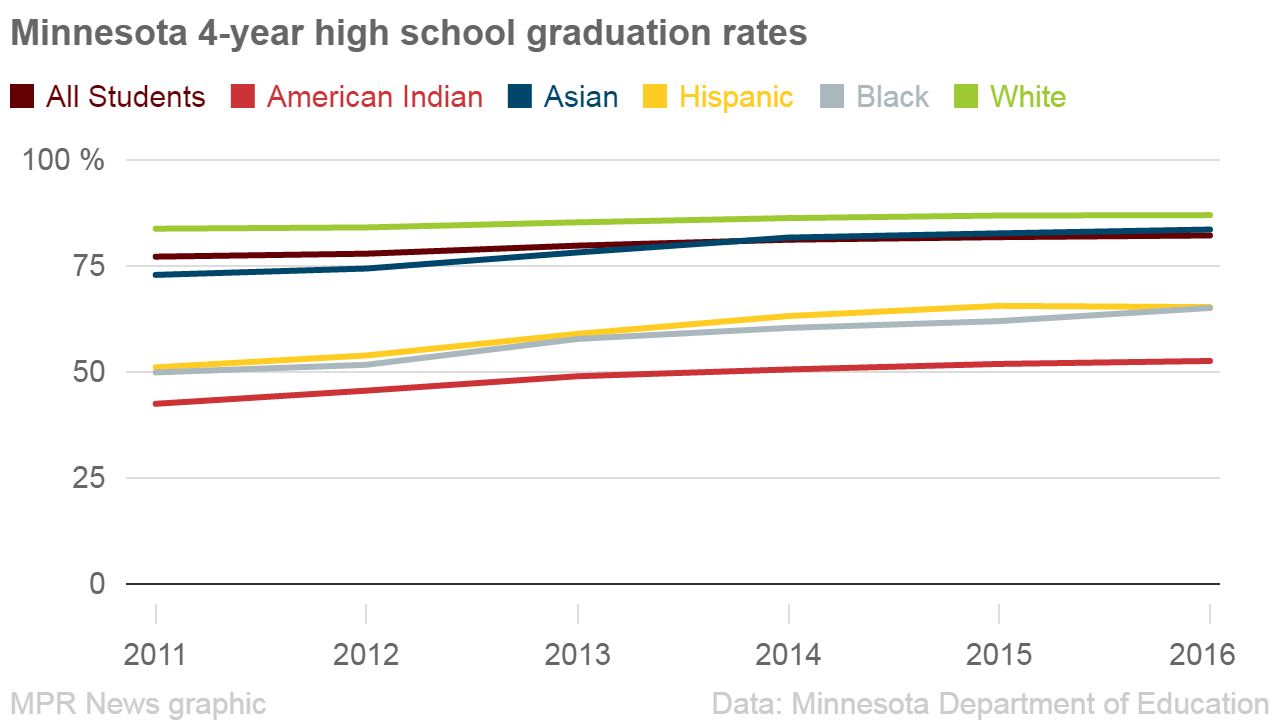Minnesota's high school graduation rates inched up last year, as racial gaps narrowed slightly
Go Deeper.
Create an account or log in to save stories.
Like this?
Thanks for liking this story! We have added it to a list of your favorite stories.
Updated: 5:02 p.m. | Posted: 12:07 p.m.
Minnesota's four-year high school graduation rate rose to 82.2 percent last year, a 0.29 percentage point improvement over 2015, according to figures released by the Minnesota Department of Education on Thursday.
Persistent racial gaps narrowed as well, with all racial groups except for Hispanics showing improvements. But students of color still lagged well behind their white peers, graduating at a 69 percent rate compared to 87 percent for white students.
Turn Up Your Support
MPR News helps you turn down the noise and build shared understanding. Turn up your support for this public resource and keep trusted journalism accessible to all.

Black students led all improvements, with a better than three-point gain to 65.1 percent.
"Graduating high school is a crucial step in attaining the dream we all have for success in life," Education Commissioner Brenda Cassellius said in a statement. "It is encouraging to see more Minnesota students — especially more of our students of color and American Indian students — reaching this milestone."
However, the gains aren't happening fast enough to hit 90 percent on-time graduation by 2020, a goal Minnesota set when seeking a waiver of federal No Child Left Behind requirements several years ago.
"In order to close gaps, we need to see all boats rising, but our students of color and American Indian students need to move faster," said Cassellius. "We're seeing that happen across the state, and we need to double down on efforts to help every student earn a diploma."
But this story is sounding a lot like last year: statewide rates inched up, officials cautiously celebrated.
Over the long term there's been a lot of this slow, steady increase. Statewide gains total about 5 percent in five years.
Johns Hopkins University professor Robert Balfanz said incremental gains like these are in one sense a good sign — an indication that educators here aren't taking shortcuts that have turned up elsewhere to make the numbers look better.
"We tend to see that as evidence that folks are starting to work the problem more, sort of paying attention to kids earlier, recognizing it's important for all kids to graduate, it's really not OK for some to graduate and not others," he said.
Balfanz said Minnesotans are maybe just waking up to a problem: the state compares unfavorably with many others on graduation, especially when it comes to students of color. In 2014, Minnesota's graduation rates for students of color were some of the worst in the country.
Minnesota's graduation rates for students of color are still far behind those for white students. For example, just over half of American Indian and Alaskan native students got a diploma in four years. About two-thirds of black and Hispanic students did. The rate for white students is 87 percent.
"We can't leave this up to schools alone," said University of Minnesota professor Michael Rodriguez. "The graduation rate should also be an indicator of the quality of our health care systems, our transportation systems, our employment opportunities, our affordable housing availability — not just school quality."
This year, racial gaps slowly inched closed statewide — black students made the most progress. Hispanic students actually fell a little further behind. Minneapolis followed the same pattern, with Hispanic students dropping almost 7 percentage points. That's compared to last year when the district celebrated a double-digit gain for Hispanic students.
Gaps widened for all racial groups in St. Paul. That may be due to a school curriculum still geared toward a so-called "mainstream," said Theresa Battle, St. Paul's assistant superintendent for high schools.
"It may not reflect, or it does not reflect, all of the different cultures and racial groups we have within St. Paul," Battle said. "So our teachers always have to supplement all their materials to make sure that the students' culture and their experiences are reflected."
St. Paul officials did cheer their overall rate of 76.5 percent, a 1.5 point gain and an all-time high for the district.
One place where gaps closed significantly was Rochester. Although black and Hispanic students still graduate at lower rates than white students in the district, the disparities improved by double digits.
Superintendent Michael Muñoz credits a combination of things — including identifying struggling students early, in-school support staff and new career-oriented courses. The district opened a career center on a community college campus this year.
"We had a small percentage of kids that we just didn't have the right type of programming that matched their interest," Muñoz said. "So I think having something that lets them grab on to and be engaged in school is going to motivate them to want to stay in school."




